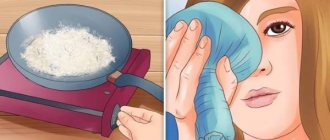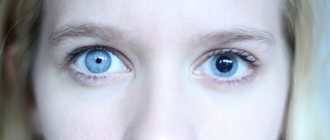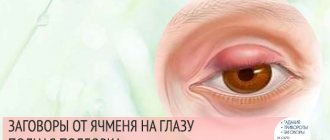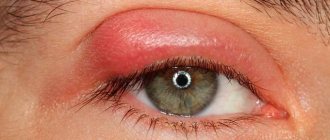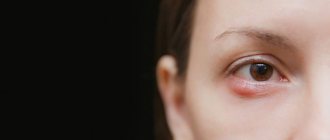Nature of the disease
Barley (hordeolum) is an acute inflammation accompanied by the discharge of pus. The disease is caused by the penetration of pathogenic bacteria into the meibomian glands, which produce a liquid secretion to lubricate the conjunctiva and corneal layer. In this case, we are talking about internal barley, which is difficult to heal. If bacteria penetrate the clogged sebaceous glands located on the edge of the eyelid, we are talking about an external stye.
The causative agent of the disease is Staphylococcus aureus (a conditionally pathogenic microorganism), the carrier of which is every second inhabitant of the planet. With strong immune defense, staphylococcus does not show its aggression towards human health, but when the immune system is weakened, the picture changes. This is why young children most often get stye.
Hordeolum appears only on one eyelid. Most often, only one focus of suppuration is formed, but there are cases of multiple barley. With serious deviations in health, hordeolum can take a chronic form. In rare cases, an abscess does not form, and a hard lump forms on the eyelid. This disease is called chalazion; the inflammation can only be eliminated through surgery.
What is barley?
Barley (hordeolum) on the eye is a disease of the upper or lower eyelid, which is infectious and inflammatory in nature. The skin along the eyelash line has a large number of sebaceous glands. Upon penetration into their cavity, the infection begins to develop. Inflammation of small vessels and adjacent tissues occurs. The disease is accompanied by the formation of a purulent sac, which grows and moves to the edge of the eyelid.
Depending on the location, barley is divided into 2 types:
- 1. External. Formed in the hair follicle of the eyelash or sebaceous gland. It sticks out, turning the skin bright pink or yellow. This type of stye is clearly differentiated on the eye. It is possible to trace the accumulation of pus in the bag.
- 2. Internal. The abscess is located on the inside of the eyelid. On the outside, there is only swelling in the form of a tubercle. The skin does not always turn red, since pathological processes occur internally. The formation of this type is caused by inflammation of the meibomian gland, which secretes lubricant for the conjunctiva.
Both forms of the disease are caused by Staphylococcus aureus and are contagious to humans. After the outer stye breaks through, the pus gets onto the skin. The internal one is more dangerous, since the pathological process comes into contact with the eyeball. Depending on the number of ulcers, stye on the eye can be single or multiple. Relapses occur after inflammation and infection spread to neighboring hair follicles.
Barley
The disease becomes chronic when the immune system is weakened and there is no treatment.
Contagiousness
Is stye contagious to others? Any purulent infection poses a threat to health, as it contains toxic waste from pathogens. Barley is no exception. However, it is not airborne, so there is no need to worry.
You can become infected only through direct contact with affected tissues or pus. But doctors warn that you can get an infection not only through contact with the affected eyelid. When using personal hygiene items for a sick person, bacteria can spread to the skin of a healthy person.
It is especially dangerous to use cosmetics from a sick person, since microparticles of pus can be transferred to healthy eye tissue.
Sleeping together with a sick person is also dangerous, since at night the abscess can open and particles of pus fall on the skin of a healthy person.
Children are at risk of contracting an infection because they do not understand the dangers of contact with a sick child. The stye does not cause illness, and the sick child goes out for a walk with his peers. Healthy children can become infected through the hands of a sick person, with which he could touch his eyelids.
The risk of infection increases when particles of pus get on the mucous membranes (mouth, eyes, lips, nose), since they are most sensitive to bacteria.
The risk of infection increases with existing ophthalmological disease (keratitis, conjunctivitis). In this case, contact with the patient must be stopped until complete healing.
When an internal abscess ruptures, there is no danger of infecting others; the pus exits into the conjunctival sac and infects the patient himself.
Note! There is no need to be afraid of becoming infected with barley, however, precautions during contact with the patient are necessary.
If your child is sick, teach them the importance of washing their hands after touching their face or eyelids. It is better to use antibacterial or laundry soap. The child must have a separate towel and an individual handkerchief.
Absolutely non-contagious - myth or truth?
When doctors say that stye is not contagious, they really are not deceiving their patients. There are several well-founded and logical arguments:
- Barley forms strictly locally, that is, on or inside the eyelids. To become infected, you will need close and fairly prolonged contact between a healthy person and a sick person. However, even very close people hardly touch each other with their eyelids or eyes. Therefore, stye on the eye cannot be dangerous for others.
- Pathogenic microorganisms contain pus inside the stye sac. There are no bacteria on the surface. But even the pus inside is very small, so even after rupture the stye is harmless.
- Statistics have proven that in 80% of cases, barley breaks out at night when a person is sleeping. If pus gets somewhere other than the patient’s face, it will only be on his pillow, and not on the person sleeping next to him. Therefore, the infection does not spread further, therefore, barley is harmless.
Unfortunately, barley is not considered a reason for sick leave, but if it appears, especially in a child, it is better to spend a few days at home until it fully ripens and ruptures
It sounds very soothing, so even if the abscess on the eyelid is about to burst, adults go to work without hesitation, and children are sent to school or kindergarten. However, stye is an infectious ophthalmic disease caused by bacteria. This means that some caution is still needed to avoid spreading the infection and infecting other people.
Prevention
Barley can pose a threat to a healthy person only under the appropriate conditions:
- direct contact with purulent discharge;
- ophthalmological diseases;
- colds;
- low immunity.
In other cases, an abscess on a person’s eye does not pose a threat to health. However, you should still adhere to preventive safety measures. After contact with the patient, it is recommended to sanitize your hands. Try not to touch your face and eyes, as well as mucous membranes (nose, lips) with unwashed hands.
Teach your child to wash his hands after a walk, as well as after using the toilet and before eating. When hand hygiene becomes a habit, many contagious infections will be avoided.
Each family member should have an individual towel in the house. Doctors have convincingly proven that many pathogenic bacteria can enter the body through the use of other people's personal hygiene items.
If someone in the family has stye, you need to regularly change their pillowcases and towels. It is better to boil the linen, and after drying, iron it with a hot iron on all sides.
To avoid suffering from infections, you need to regularly strengthen your immune defense and lead a healthy lifestyle. Prevention of diseases is always easier and cheaper than long-term treatment.
Causes
Barley may appear:
- with decreased immunity;
- hypothermia;
- hypovitaminosis;
- a previous cold;
- viral diseases;
- conjunctivitis;
- otitis;
- sore throat;
- diseases of the upper respiratory tract.
A distinctive sign of the disease is the appearance of a tubercle on the eyelid, which causes discomfort when blinking and becomes a source of pain. This tubercle resembles a grain of barley in shape and size, hence its name. It can appear on the outer or outer side of the eyelid; the causes of the pathology are identical.
There are cases in which several styes are found in one eye at once. This is usually seen in people with poor immune systems.
It is not typical for stye to transfer to the second eye. In rare cases, it can cause complications and become abscessed.
First aid
If preventive measures do not help, and the eyelid begins to turn red and itch, you need to start treatment. At the first manifestations of hordeolum, you can save the situation with the help of iodine, brilliant green or alcohol. You should first disinfect your hands, and then carefully cauterize the area of redness with iodine/green paint. You can put antibacterial eye ointment in the conjunctival sac.
Note! Cauterization with brilliant green must be carried out very carefully so that the solution does not get on the mucous membrane of the eye.
Until pus appears, dry heating can be carried out. To do this, apply a boiled moderately hot egg to the eyelids (do not peel) or heat a linen bag with salt in a frying pan and warm it up. Instead of eggs, use jacket potatoes, and instead of salt, use flax seeds. The egg and potato are wrapped in clean cotton cloth. If you do not miss the time, such procedures completely stop the development of inflammation.
If these methods do not help, ophthalmic ointments are used to stop the development of suppuration:
- Acyclovir;
- Levomekol;
- Tetracycline.
Ophthalmic drops are also used in combination with ointments:
- Tobrex;
- Albucid;
- Levomycetin.
If the abscess begins to mature, then aloe/kalanchoe juice can help quickly open it. The bottom leaf of aloe is thoroughly washed and crushed. Squeeze the juice out of the resulting mass through gauze and lubricate the eyelid with the healing liquid. You can soak a cotton pad in the juice and apply it to the sore eye.
To reduce itching, you can wash the eyelid with cool decoctions of medicinal herbs:
- chamomile;
- sage;
- plantain.
It is strictly forbidden to warm up the suppuration. Washing the eyelid is carried out with cool infusions, not higher than room temperature. Heating the source of inflammation promotes the spread of infection to adjacent healthy tissue.
During treatment for stye, you should not use contact lenses.
Multiple stye cannot be treated at home, as self-medication will lead to serious consequences. The same applies to internal stye, which forms on the inside of the eyelid. These pathologies are treated with strong antibacterial drugs, and sometimes surgical procedures are required.
To strengthen the immune defense, you need to take immunomodulators or restoratives. Echinacea (tablets, alcohol solution) improves immunity well. You can buy a special liquid for applying therapeutic compresses to the affected eyelid. The compress will increase local immunity, and echinacea in tablet form strengthens the overall immune status. However, the use of echinacea must first be discussed with an ophthalmologist; in some cases, its use is unacceptable.
The abscess cannot be squeezed out.
To increase immunity and destroy infection in the body, propolis tincture is used. You can prepare a water infusion yourself, or you can purchase an alcohol tincture from a pharmacy. Drops are diluted in water/milk and taken orally. However, the drug is allergic, so you need to be sure that the body can tolerate propolis. At the first symptoms of allergy (tissue swelling, pain, rash), treatment with propolis should be stopped.
Stye in a child
ATTENTION!
Before asking a question, we recommend that you read the contents of the “Frequently Asked Questions” section. There is a high probability that you will find the answer to your question there right now, without wasting time waiting for an answer from a consultant doctor. Dear visitors of the portal! The “consultations” section is suspending its work.
The archive of medical consultations for 13 years contains a large number of prepared materials that you can use. Best regards, editors
Sorting: by usefulness by date
March 10, 2011
Olga asks:
Hello! My girl has a stye on the lower eyelid of her left eye, swelling with a purple tint around the eye. I tried to warm it up with a boiled egg - hysterical, it didn’t work, I won’t take you to the doctor (it’s cold). The child's behavior is no different from usual. Please advise how and what to treat? Thank you
May 05, 2011
The Medical Consultant of the portal “health-ua.org” answers:
General doctor
All consultant answers
Hello Olga! Refusing an in-person consultation with a specialist on the basis of cold weather is stupid; your child is old enough to endure the trip from home to the children's clinic even in winter. Stye is a disease that is fraught with serious complications (in the absence of adequate treatment), so show your child to an ophthalmologist and do not look for unnecessary problems. Take care of your health!
February 20, 2013
Yana asks:
My daughter is 10 months old. There were purulent inflammations on both upper eyelids, which broke through and now there were dry crusts and slightly inflamed skin.
One clinic diagnosed chalazium and prescribed Tobradex and tetracycline ointment at night. Help me decide on a diagnosis. Not a single ophthalmologist prescribed a diagnosis. I'm afraid to start the process.
Yesterday another inflammation appeared on the lower eyelid. Please describe the step-by-step diagnosis of the cause of this process.
February 25, 2013
Elena Stanislavovna Prokhvachova answers:
Hello, Yana. Diagnosis of chalazion is based only on its clinical manifestations, i.e., by appearance and complaints. Repeated inflammation of the eyelids (hordeolum, meibomitis) requires anti-inflammatory treatment, which is prescribed by a pediatric ophthalmologist, and consultation with a pediatrician to clarify the balance of the child’s diet and prescribe medications that increase immunity. I wish you health!
May 30, 2011
Maria asks:
Hello! My daughter developed a stye inside her left upper eyelid. Swelling appeared. We went to the doctor and wrote out a prescription for drops, the swelling went away, but after 10 days it reappeared. Again we went to the doctor and prescribed treatment with Combinil-Duo and Polinadim went away, but again after 5 days swelling appeared. What can I do? Can this be cured or only with surgery?
June 14, 2011
Kozina Ekaterina Nikolaevna answers:
Apparently, the process was undertreated and the cause of the disease was not eliminated. Examine the child, take urine and blood tests, including tests for sugar and sterility. It is necessary to treat, but not surgically, but with medication. Local ointments, drops, internal restoratives, vitamin preparations. Physiotherapy, warming up at the resorption stage. At the same time, consultation with a gastroenterologist and pediatrician.
05 February 2012
Victoria asks:
Our child developed barley 2 days ago, was treated according to the method of this article https://www.spinceara.org/2012/02/04/kak-lechit-yachmen-na-glazu-u-detey/ the results of treatment are not yet visible, Is the treatment described in this article correctly? If it is not written entirely correctly, please advise something else. Thank you very much in advance!!!
07 February 2012
Elena Stanislavovna Prokhvachova answers:
Hello, Victoria, everything in the article is written correctly. As for your child, I advise you to use Tobrex or Floxal drops 6 times a day for at least 5 days, maximum 7. The rest of the treatment depends on the stage of the process, warming is no longer necessary (given 3 th day of illness), if there is no reaction from the lymph nodes, then this treatment will be sufficient. I wish you recovery!
July 16, 2012
Tatiana asks:
what to do when the upper eyelid of the eye is swollen and red. How to treat stye? We visited the doctor, he said that it looked like barley, he prescribed Veshnevsky ointment, apply it to the pad and bandage it around the head for three hours, and after three hours change the bandage.
I felt scared to do this anywhere, even on the Internet I had never heard of this method. I warmed it with a warm egg twice today. And the pediatrician said that nothing bad will go away on its own, don’t worry, drink Diazolin, buy some children’s eye drops at the pharmacy….
I don’t know what to do; there is no other children’s doctor in our city, and this ophthalmologist also works in a private clinic. Help me please!!!!
November 05, 2012
Elena Stanislavovna Prokhvachova answers:
Hello Tatiana. Treatment with Vishnevsky ointment is an old, proven method; be careful not to get it into the eye. Also use Floxal or Tobrex drops at least 4 times a day for 5-7 days. Thermal procedures are not needed, diazolin will not harm. If eyelid swelling and redness spread, be sure to contact a pediatric ophthalmologist. I wish you recovery!
November 13, 2013
Anna asks:
My son has an inflammatory process in his body, barley in both eyes and red, pimple-like, inflamed formations, bumps in the groin and behind the ears. I visited an ophthalmologist and was prescribed Floxal eye ointment and sodium sulfacyl 20%. what antibiotics should I buy to completely cure my child?
November 20, 2013
Prayer Oksana Vasilievna answers:
To treat stye, it is better to use “Ocomistin” or “Oftamirin” eye drops plus “Tobradex” eye ointment, drip and place behind the eyelids and lubricate the eyelids from the outside 3-4 times a day. Regarding lumps in the groin localization, you should rather consult a urologist, and for ears, see an ENT specialist. This is an enlargement of lymph nodes. You can initially contact a therapist.
March 13, 2020
Natalya asks:
Hello! We got barley a month ago... we heated it with an egg and it was all in vain (it didn’t help us (We went to the doctor, he prescribed TOBRODEX ointment 3 times a day and Okomistin drops 3 times a day... we treated for 7 days and there was no change. Tell me Help
April 24, 2020
The Medical Consultant of the portal “health-ua.org” answers:
General doctor
All consultant answers
Hello! Delayed initiation of treatment and self-medication often lead to subsequent professional therapy being less effective than usual. In this situation, you need to show the child to the doctor again: the doctor must examine the child, understand why the treatment is not effective enough, and make changes to the treatment regimen. Take care of your health!
February 21, 2020
Lilia asks:
My daughter constantly has a stye under her eye! We didn’t go to the ophthalmologist because he wouldn’t say anything (I’ve been dripping two drops into her eyes 4 times a day for the 3rd day now, and washed her eyes with a decoction of chamomile!
But nothing helps (Help me find a way to get rid of stye as quickly as possible in a couple of days)
February 25, 2020
Elena Stanislavovna Prokhvachova answers:
Hello, Lilia. It is not always possible to get rid of barley in a couple of days. Apply antibiotic drops - Floxal or Tobrex 4 times a day for 7 days. Recurrent styes occur with a decrease in general immunity, chronic infections of the ENT organs, teeth, and helminthic infestations. Once the underlying problem is eliminated, the stye will go away on its own. I wish you recovery!
January 09, 2008
Irina asks:
Hello! My child is 2 years old, we have small balls on our eyelids, the doctor says it’s meibomitis. We’ve been using drops for 3 weeks now, there are results, but so far these balls are going away very slowly. The doctor plans to prescribe antibiotics, how bad are antibiotics for the eyes? How long can the course of treatment last? Are there specialized sanatoriums in Ukraine? You don’t want antibiotics...
January 16, 2008
Sergey Anatolyevich Prozhoga answers:
Hello. The course of antibiotic treatment usually lasts 10-14 days. In general, in addition to drops, eyelid massage and treatment of the marginal surface are prescribed. Blockage of the meibomyoma gland is often a sign of a disorder in fat metabolism in the body, therefore, in addition to local treatment, consultation with a gastroenterologist is necessary. It is also advisable to take a culture test on the edges of the eyelids.
December 23, 2010
Veronica asks:
Hello! Two days ago, two painful lumps appeared on my daughter’s upper eyelid from the inside, now they are already appearing on the second eye, what is this, please help me! How to treat it!
07 February 2011
The Medical Consultant of the portal “health-ua.org” answers:
General doctor
All consultant answers
Hello, Veronica! The cause of the appearance of seals on the moth's eyelid is blepharitis, barley, chalazion and other ophthalmological diseases. Since it is possible to distinguish these diseases from each other and, accordingly, make a diagnosis only after examining the child, we recommend that you seek an in-person consultation with a pediatric ophthalmologist. Take care of your health!
December 03, 2020
Margarita asks:
Hello, my child has a stye on his eye that hasn’t gone away for two weeks now and constantly breaks out first on the lower eyelid, then on the upper... I drip the eye every two hours with drops of chloramphenicol and drops of okomistin, as prescribed by the ophthalmologist, but the stye never goes away! Tell me, what else can be done?
December 14, 2020
Elena Stanislavovna Prokhvachova answers:
Hello Margarita. Recurrence of barley indicates a weak immune system, the presence of foci of chronic infection (in teeth, gastrointestinal tract organs, ENT organs), and helminthic infestation. Contact your pediatrician to diagnose common illnesses in your child. With successful treatment of these diseases, stye will go away on its own. I wish you recovery!
September 27, 2012
Lesya asks:
Good afternoon We have not been able to get rid of barley for 2 months now. There are even several of them on one eye. the first appeared after vaccination, probably due to decreased immunity. I take antibiotics all the time...
Not a single doctor can tell what’s wrong, it seems to go away with drops of aloe and potassium iodide so that it resolves, a week later it relapses again. I read that it could be Staphylococcus aureus.
How do we find out? and what should I do anyway? thank you in advance!
October 01, 2012
Elena Stanislavovna Prokhvachova answers:
Hello, Lesya. The causative agent of barley is usually Staphylococcus aureus; broad-spectrum antibiotics should cope with it. But the problem is relapse. Use multivitamins, brewer's yeast, and herbal preparations that enhance immunity. Examine the child's gastrointestinal tract. I wish you recovery!
08 October 2009
Lesya asks:
I caught a cold when I started to recover, there was swelling and itching on my right eyelid, I gave birth to a child four months ago and am breastfeeding him. Can this affect the milk? and how to restore immunity to a nursing mother?
October 15, 2009
Oksana Sergeevna Averyanova answers:
Ophthalmologist, Ph.D.
All consultant answers Good afternoon. The appearance of a local inflammatory focus does not affect the composition of breast milk if you do not use medications internally for treatment. in particular antibiotics. It is better to restore the immunity of a nursing mother through general hardening measures - physical education. active lifestyle, good sleep and proper nutrition.
June 04, 2013
Julia asks:
Hello! A 5-year-old child has a third stye popping out on his eye in the same place (on the upper eyelid at the outer edge). All three styes popped up about 3 weeks apart.
The first one was small, but it went away with the temperature, as soon as it broke through the temperature immediately went away and after 2 days the barley was gone.
The second one didn’t really have time to come out at all and immediately went away, but the third one seemed to be large in size, but it broke through on its own and there was little pus, but the swelling went down the eye, as if even under the eye.
At first I dripped (before it broke through) sodium sulfacyl, and at night I put tetracycline ointment under the eyelid, now (after it broke through) - ciprofloxacin-acos 0.3%. This is the second day since it broke through, but the swelling hasn’t really subsided. I started to worry, but the doctor really couldn’t say anything intelligible. Help me please.
June 10, 2013
Elena Stanislavovna Prokhvachova answers:
Hello Julia. Continue to instill the antibiotic for at least 5-7 days; as the inflammation subsides, the swelling of the eyelid will subside. The cause of recurrent styes is decreased immunity. Contact your pediatrician to prescribe vitamin supplements, diet and herbal remedies to correct immunity. I wish you recovery!
October 11, 2013
Allah asks:
Hello! My 7-year-old daughter developed stye. Can I go to school?
November 06, 2013
The Medical Consultant of the portal “health-ua.org” answers:
General doctor
All consultant answers
Hello, Allah! A child with stye should not be sent to school, but taken to an appointment with an ophthalmologist, so that the doctor, after examining the eye, confirms that there really is a stye and gives recommendations for adequate treatment of the detected disease. One missed day of school will not be a big problem for your daughter. Take care of your health!
only 14 pages
Source: https://deti.health-ua.org/mc/detskaya-oftalmologiya/1893/4/
Bottom line
Is stye contagious to others? It depends on the degree of contact with the sick person. If you do not hug the patient or kiss him on the cheek, it is impossible to contract the infection. Also, you should not use the patient’s personal hygiene items so that pathogenic microbes do not get on the skin of the hands or mucous membranes of the face. Barley is not airborne, so there is no cause for concern. However, doctors advise maintaining hand hygiene after contact with a patient, and also not using his personal belongings.
When treating hordeolum, you need to be very careful not to provoke the infection to penetrate deep into the tissues and spread to healthy tissues. If the eyelid is red, it is recommended to cauterize the area with brilliant green; in the evening, you can warm the eyelid with dry heat. If this does not help, you will have to use ophthalmic ointments and drops. In difficult cases, surgical intervention is indicated. To prevent the development of barley, you need to maintain personal hygiene, strengthen your immune system, dress according to the season, and sanitize your hands after tactile contact with a patient.
Sources used:
- Complex diagnosis of fundus pathology / Gabriel Coscas, Florence Coscas, Alain Zurdan. - M.: Practical Medicine, 2007.
- Eye injuries / R.A. Gundorova, A.A. Malaev, A.M. Yuzhakov. - M.: Medicine, 1986.
- Essays on the history of ophthalmology in St. Petersburg / L.I. Balashevich, V.G. Shiryaev. - M.: St. Petersburg Medical Academy of Postgraduate Education, 2000.
- Wikipedia article
Is there a chance to “catch” an eye stye from others?
But is barley contagious or not?
Opinions about the contagiousness of this disease are divided. There are arguments for each side, and they look quite convincing. Here are the arguments supporting the idea of barley as a non-contagious disease:
- it occurs on the face and cannot be transmitted because most people do not have skin contact;
- the infection is located under the skin, so it is not dangerous;
- most often the stye breaks through at night, and a small amount of pus flows out.




